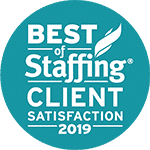Managing your staff is no small task. It can be even more time-consuming if you are managing numerous types of employees. In the industrial industry, it isn’t uncommon to have a number of full-time, part-time, and even temporary staff all working at once. Since the COVID-19 pandemic, temporary employees have become even more common, making it important to manage these team members effectively. Below are some strategies for managing temporary laborers and industrial employees.
Reassess Your Strategy
The job market is hot right now, and industrial employees are in high demand. You may find yourself in a position where you have too many qualified applicants. While this isn’t necessarily the worst position you could be in, it makes reassessing your strategy a must. If you find that many of your temporary employees are working overtime or tend to have a long tenure, consider moving to a temp-to-hire model. This can help you manage the overall cost of your workforce.
Update Your Onboarding Process
After you have assessed your hiring strategy, you should take a close look at your onboarding process. Many companies are no longer able to rely on in-person onboarding programs due to the pandemic. This means many organizations need to update their onboarding process to take care of administrative tasks remotely. For instance, paperwork has been shifted to being signed and processed digitally.
Recalibrate Labor Demand Management
In some cases, companies have discovered the need to lay off full-time employees and focus on staffing their organization with temporary workers. For some employers, this has made it easier to mitigate labor costs during trying economic times. It also helps manage the uncertainty around industry demands. It is important to recalibrate your labor demand and decide what can be handled by temporary staff and what you may need permanent hires for.
Develop a Remote Work Model
Some positions in your organization may have the capacity to be worked remotely. This can open up access to a wider talent pool and reduce the risk of the spread of illness at work. However, if you have not ever managed remote workers before, you will need to develop a remote work model. To do this, invest in software and communication platforms to make it easier to stay on top of important tasks. You should also invest in tracking for your employees to see where their time is being spent and whether any adjustments need to be made or not.
Factor in Risk Mitigation
Many employers have utilized temporary employees in the industrial industry during the pandemic by filling in gaps in their staff when someone is out sick. Temp workers can step in and keep workflow continuous. You can establish collaboration tools that will allow you to see who is available to work when you are in need of someone to fill in the gaps.
Consider Benefits for Temp Employees
Because temp employees are in such high demand right now, there has been a call for the benefits afforded to full-time staff to be extended to temporary workers as well. This may increase the cost of hiring temp employees for the company, but it will pay off in an expanded talent pool and access to more qualified candidates.
GoSource Can Help You Find Temporary Employees
Working with a staffing firm can help you manage your temporary laborers with ease. Learn how GoSource can help you with managing temp employees in the industrial industry.






